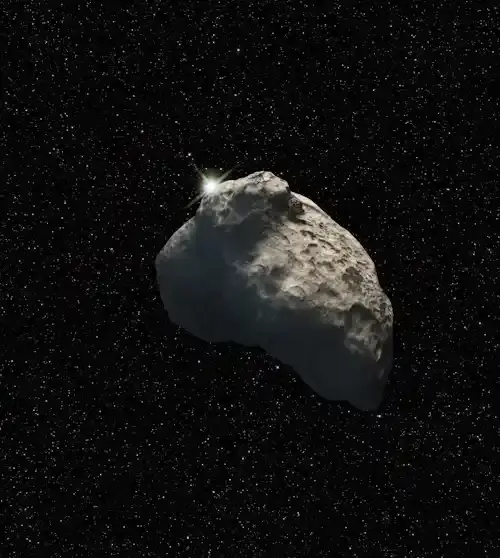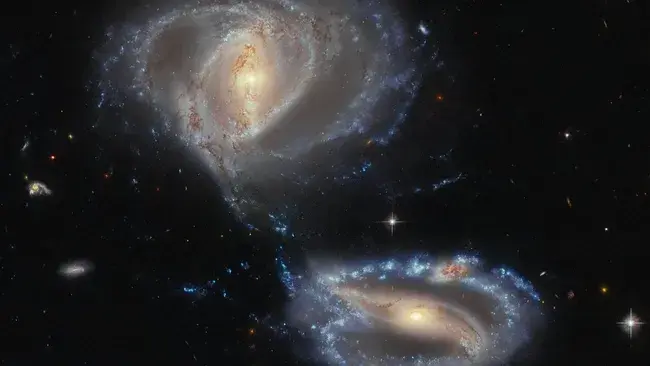Sudden asteroid lights up the sky of the Philippines
Astronomers are becoming more able to observe asteroids that may collide with Earth. We have now spotted nine asteroids before they collided with Earth's atmosphere. The latest space rock spotted before hitting Earth burned up in the atmosphere over the Philippines on September 5, 2024. By identifying dangerous asteroids sooner, we have a better chance of mitigating potential impacts and reducing the risk of disaster.
What are asteroids?

Asteroids are the remaining material from the formation of our solar system that has not become part of the planets and moons. Asteroids come in all shapes and sizes. Gravity determines its trajectories and is fairly predictable. Of particular interest are near-Earth objects (NEOs). As of September 2024, we know of approximately 36,000 such objects, ranging in size from several meters to a few kilometers. But statistical models predict that there are nearly a billion such objects. We know very few of them.
Recommend
Asteroid observation

We have been monitoring these asteroids since the eighties of the twentieth century and conducting more detailed surveys of them since the nineties of the twentieth century. Surveys use telescopes to make observations of the entire sky every night. Then they compare photos of the same area on different dates. Astronomers are interested in finding out if an object has moved in the same area of the sky relative to stars from night to night. Any object that has moved could be an asteroid. Monitoring its locations over a longer period allows team members to determine its exact trajectory. This, in turn, enables them to predict where it will be in the future, although data collection and analysis is a time-consuming and patient process. This is made more difficult by the fact that there are much smaller objects than larger ones. However, some of these smaller objects are large enough to cause damage on Earth, so we still have to monitor them. They are also dull and therefore difficult to see with telescopes. It can be difficult to predict the trajectories of smaller objects in the distant future. This is because they interact gravitationally with all other objects in the solar system. Even a small gravitational force on a smaller object can change its future orbit over time in unpredictable ways.
2024 RW1
With humanity's eyes focused on the sky, it's rare for an asteroid to surprise us. But that's what happened over the Philippines. Just hours after its discovery, it burned in a bright flash over the island of Luzon. NASA's Catalina Observatory discovered the small asteroid, now dubbed 2024 RW1, just hours before it reached Earth's atmosphere. It was only about one meter in diameter and posed no threat. Although reports say it "hit Earth", it actually only hit the atmosphere, where small objects burn. This is only the ninth time we have detected an asteroid before it reaches Earth, although the European Space Agency says a one-metre asteroid hits Earth every two weeks. Video taken from the northern tip of the Philippines shows a flashing fireball partially obscured by clouds. The asteroid briefly created a tail, then quickly disappeared. The feeling of surprise by an asteroid is unusual. But even though it was a surprise, it was discovered before it reached us. We can rest assured that our automated celestial surveys have detected such a small object. If it had been large enough to cause any amount of damage, it would have been brighter and we would have been able to detect it much sooner. Although this body posed no danger, this is not always the case. In 2013, an 18-ton near-Earth asteroid called the Chelyabinsk meteorite exploded over the Russian city. It caused extensive damage to the land and caused nearly 1,500 people to seek medical help, although no one was killed. The Earth has suffered far more catastrophic effects throughout its history, and this ghost haunts our civilization. The Chicksulp effect caused a mass extinction and ended the dinosaurs.
The Friedfurt crater in South Africa was dug two billion years ago by an impact object with a diameter of 10 to 15 kilometers. But it's not just the size of the asteroid that's the problem. Asteroids hit the Earth very quickly. The European Space Agency says 2024 RW1 was traveling at 17.6 kilometers per second, or 63,360 kilometers per hour, the average speed of these objects. Both NASA and ESA actively search for asteroid counts and records. NASA also invites experts to participate in regular mock exercises. In these exercises, teams of people are provided with regular fabricated updates about the approach of a dangerous asteroid and asked to take any actions they deem appropriate. The 2024 RW1 was not a threat. In fact, it's a beautiful landscape. But it's also a reminder that Earth is not isolated from the universe, although in everyday life, it may seem so.
![]()
Explore your nature lighting show: Tyndal the effect of weather phenomena
The Tyndall effect turns light and air into a stunning dance of color and mystery. From golden rays to misty glows, nature paints breathtaking scenes that captivate the eye and soul—and it’s all thanks to tiny particles playing with light in extraordinary ways. more- ADVERTISEMENT
![]()
Hospice of the King's Assistant... Masterpieces of art and color harmony in Kermanshah
The King’s Assistant Hospice in Kermanshah, a Qajar-era gem, shines with vivid tiles and graceful arches. Built for religious ceremonies and tribal reconciliation, it also holds tales of conflict, peace, and deep-rooted Persian hospitality. Today, it stands as a museum and a beautiful reminder of cultural and spiritual legacy. more- ADVERTISEMENT
![]()
Tips to increase productivity while working from home
Working from home offers comfort and flexibility, but staying productive needs clear goals, a proper workspace, and strong self-discipline. Organizing your day, taking short breaks, and creating work-life balance are key. A good chair is worth it—and so is setting boundaries between work and personal time. more- ADVERTISEMENT
![]()
Can you really master a skill by learning for one hour a day?
Can You Really Master a Skill by Learning for One Hour a Day? more- ADVERTISEMENT
![]()
Proven ways to build your confidence
Self-confidence isn't about being perfect—it's about knowing your strengths, embracing your flaws, and growing through experience. Celebrate small wins, speak kindly to yourself, and keep learning. With each step forward, you’ll prove to yourself that you are capable and ready for life’s challenges. more- ADVERTISEMENT
![]()
Sama Beirut... Unique skyscraper
Sama Beirut, Lebanon’s tallest tower, rises with elegance in Achrafieh, offering stunning sea and mountain views. Built by Fadi Antonios out of love for his homeland, it blends green space, luxury living, and modern safety features—all in one iconic landmark symbolizing hope and resilience. more- ADVERTISEMENT
![]()
Social entrepreneurship: How do your projects make a positive impact on society?
Social entrepreneurship is all about using innovative ideas to solve social and environmental problems while creating jobs and boosting the economy. It’s growing fast in the Arab world, especially in places like Egypt and the UAE, offering hope for a better, more sustainable future despite funding and awareness challenges. more- ADVERTISEMENT
![]()
Why does my mood change when I'm hungry?
Feeling hungry can mess with your mood—fatigue, anger, confusion—all thanks to low glucose. As levels drop, stress hormones like cortisol and adrenaline kick in, making you irritable. Even fish get aggressive when hungry! So grab a healthy snack, keep calm, and maybe save your relationships along the way. more- ADVERTISEMENT
![]()
Is the universe still making new galaxies?
Is the universe still making new galaxies? more- ADVERTISEMENT
![]()
What is the future of electric vehicles in the Arab world?
Electric vehicles are gaining ground in the Arab world as countries push for cleaner air, energy independence, and economic diversification. Governments like Saudi Arabia and the UAE are investing big, launching strategies, and building infrastructure to support EVs, while also partnering with global companies to boost innovation and job creation. more- ADVERTISEMENT





















